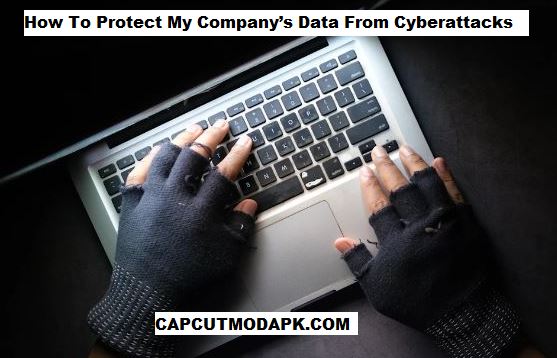How To Protect My Company Data From Cyberattacks: Data security is a top concern for businesses today. Cyberattacks are becoming increasingly sophisticated, with hackers constantly finding new ways to breach company networks and steal sensitive information. For small businesses, in particular, the risk of cyberattacks is real and often more damaging due to limited resources. A data breach can result in financial loss, damage to reputation, and even legal consequences. This makes protecting company data from cyberattacks crucial.
In today’s world, data is the lifeblood of most businesses. Whether it’s customer information, employee data, or financial records, your company’s data must be protected at all costs. While large corporations have the resources to deploy complex security systems, small businesses must take steps to safeguard their data with the tools available to them. Simple security measures can make a significant difference in reducing the risk of a cyberattack.
This article will guide you through essential strategies for protecting your company’s data from cyberattacks. From securing your network to protecting sensitive information and addressing employee threats, we will cover everything you need to know. With these measures in place, you can reduce the likelihood of falling victim to cybercrime and secure your business’s future.
Also, Read
How To Ensure GDPR Compliance For Small Businesses
What Steps Should I Take After A Data Breach At My Company?
How Can The Data Be Protected From Cyber Attack?
Protecting data from cyberattacks begins with understanding the types of threats you might face. Cyberattacks come in many forms, such as phishing, ransomware, and malware. The first step to securing your data is to secure your network and devices. Start by installing firewalls, antivirus software, and encryption systems on all devices and servers. This helps protect against external threats that attempt to breach your system.
Next, ensure your company’s data is regularly backed up. If your business relies on important digital information, creating regular backups of your data will ensure that, even if an attack occurs, you have access to critical files. Store your backups securely and use encrypted storage methods. Regular backups can also speed up recovery after a breach.
Additionally, enforcing strong password policies across your organization is critical for data protection. Weak or reused passwords are one of the easiest ways for cybercriminals to gain access to company data. Encourage employees to use complex passwords, and implement multi-factor authentication for added protection. By combining strong passwords with encryption and regular backups, your business will be much harder to breach.
What Is 1 Thing Companies Can Do To Protect Your Data?
One of the most effective things a company can do to protect its data is to train employees in cybersecurity best practices. No matter how robust your security measures are, a lack of awareness among your staff can lead to serious vulnerabilities. Cyberattacks often start with human error, such as opening a malicious email or clicking on a harmful link. When employees understand the risks and know how to spot phishing attempts or other threats, they become your first line of defense.
Employee training should cover topics such as identifying phishing emails, creating strong passwords, recognizing suspicious activity, and safely handling sensitive information. Conduct regular training sessions and refreshers to keep your team up to date with the latest threats. This kind of proactive training can reduce the chances of a successful attack and make employees more aware of their role in protecting company data.
In addition to training, encourage a culture of cybersecurity within your company. Make it clear to employees that data protection is a priority. When everyone understands the importance of securing sensitive information, you’ll reduce the chances of mistakes that could leave your company vulnerable to a cyberattack.
How To Protect Your Business Data?
Protecting business data involves a combination of strategies to secure both the physical and digital aspects of your operation. Start by implementing access controls to restrict who can access sensitive data. Not everyone in your organization needs access to all information. By limiting access based on roles, you reduce the risk of sensitive data falling into the wrong hands.
Another key measure is to use encryption. Encrypt all sensitive data both in transit and at rest. This means that even if a cybercriminal gains access to your data, they won’t be able to read it without the encryption key. Encryption is a simple yet powerful way to protect valuable business data.
It’s also important to stay up to date with security patches and updates. Cybercriminals often exploit known vulnerabilities in software that has not been updated. Make sure your operating systems, applications, and security software are always up to date. Set up automatic updates where possible to ensure you don’t miss critical patches. By keeping your software and systems current, you protect your business from known vulnerabilities and reduce the chances of an attack.
How To Protect Company Data From Employees?

While employees are crucial to your business, they can also pose a threat to data security. Insider threats, whether intentional or accidental, are one of the most common causes of data breaches. To protect company data from employees, you need to establish clear data protection policies that define what is acceptable and what is not. Make it clear to all employees what data can be accessed, shared, and used within the company.
Implement role-based access control (RBAC) to restrict data access based on job roles. Employees should only have access to the data they need to perform their duties. If an employee no longer needs access to certain data—such as when they change roles or leave the company—be sure to remove or adjust their access immediately. This helps prevent employees from having access to sensitive data long after they need it.
Also, monitor employee activity. Set up systems to track access to sensitive data and detect unusual behavior. If an employee is accessing data they shouldn’t, or if their activity seems suspicious, you’ll be able to identify it early and take action. While monitoring should respect privacy, ensuring that there is a system in place to detect potential security risks can help prevent insider threats from becoming major issues.
How Do You Protect Corporate Data When An Employee Leaves?
When an employee leaves your company, there is a risk that they may take sensitive data with them or gain unauthorized access to company resources. To protect corporate data when an employee leaves, begin by revoking their access immediately. This means disabling their company accounts, changing passwords, and locking any devices they may have had access to, such as laptops, smartphones, or external drives.
It’s also important to have an exit procedure that ensures all company data is returned before the employee departs. This includes retrieving company-owned devices, files, and any intellectual property that may be stored on personal devices. If the employee had access to cloud services or third-party applications, make sure their access is removed from these platforms as well.
Finally, conduct an exit interview to review any concerns regarding data protection. It’s a good idea to remind the employee of their confidentiality obligations even after leaving the company. If you suspect that any data was taken or misused, take immediate action to investigate and, if necessary, seek legal advice to handle the situation properly.
How To Secure Your Company?
Securing your company against cyberattacks involves multiple layers of defense. Start with building a strong cybersecurity infrastructure. Invest in firewalls, anti-virus software, and encryption tools to secure your network. It’s also essential to use a Virtual Private Network (VPN) for secure remote access, especially if employees work from home or other locations outside the office.
Next, implement strong authentication protocols. Multi-factor authentication (MFA) adds an additional layer of security by requiring more than just a password. Even if a hacker gains access to an employee’s credentials, MFA ensures they cannot get into company systems without the second form of authentication.
Regularly test your company’s security by conducting vulnerability assessments and penetration tests. These tests will help you identify weak spots in your network before cybercriminals can exploit them. Once vulnerabilities are identified, take immediate steps to address them.
Finally, ensure your company has a comprehensive incident response plan. This plan should outline the steps to take in the event of a breach or cyberattack, from identifying the issue to notifying affected individuals and reporting the breach to authorities. Having a well-prepared response plan can significantly reduce the damage caused by a cyberattack and ensure that your company can recover quickly.
Conclusion
Protecting your company’s data from cyberattacks is not just a one-time effort; it requires constant vigilance and ongoing measures. By investing in strong security systems, training employees, and implementing clear data protection policies, your company can significantly reduce its vulnerability to cyberattacks. Regularly updating software, using encryption, and monitoring employee activity are essential practices for keeping your data secure.
Cybersecurity threats are constantly evolving, so it’s important to stay proactive and adapt your strategies to meet new challenges. A solid cybersecurity framework will not only protect your business but also help build trust with customers and partners who value data privacy. With the right protections in place, your company can thrive in an increasingly digital world, safe from the risks of cybercrime.


